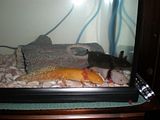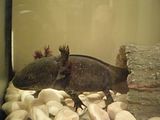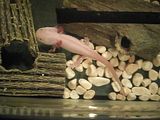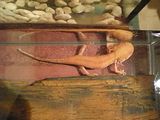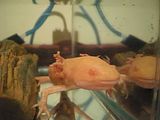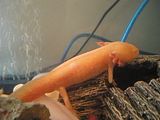Hi broadbent,
Firstly to allay your fears, yes your axolotl is an axolotl. Neke and Kira are both on the dot when they say axolotls are the only type of salamanders kept in Australia.
Thank you for also posting pictures of your axolotl which allows a better assessment of his condition. In fact, i highly recommend people to take sequential photographs of their sick axolotl over a course of time to allow a comparison of their condition and progress.
Judging from the photos, i would say in all fairness that your axolotls were initially healthy to start with and the body condition deteriorated over time. This information itself rules out genetic/congenital problem.
There is definitely evidence of stress as seen by the curled tail tip in the 6th photo. There is also signs of shrinking gills and loss of body condition with a chronic nature. Also on a separate note, i really recommend either switching to a bare bottom tank or sand substrate. The white pebbles although looking relatively large, could still pose as a pontential source of impaction. I do not see any visible signs of fungal or bacterial infection on the gills. Gills can shrink naturally when the axolotl's environment is oxygenated well.
What is most cause of concern though, is the last picture showing a well-circumscribed, white circular lesion on the flank. Although i cannot definitively tell you what it is, there are several disease processes that may mimic the lesion in terms of appearance and presentation. Some of these causes include -
- Fungal (such as by saprolegnia infection)
- Bacteria (such as by mycobateria which can form a granuloma)
- Ectoparasites (irritant to skin and can also cause lesion formation)
- Trauma (such as from an abrasion or penetrating wound)
Although there are many causes of the lesion, the only way to accurately tell what it is, is to bring it to your vet who may like to take a skin/blood/faecal sample for analysis. Even though the external skin lesion may be gone, there is a possibilty that there is a subclinical systemic presentation which can result in inappetance, ill thrift and stress.
Fortunately, there is a common panacea to treat the above conditions. Your goal now is to encourage feeding, reduce stress and inhibit microbial activity.
1) Fridging your axolotl
You might like to refridgerate your axolotl for 2 weeks under 4 degrees celsius. During this time, do daily water changes with clean dechlorinated water also kept in the fridge to prevent shocks associated with drastic temperature changes. Good idea to monitor water parameters if you can.
The rationale behind this is that the cold fridge environment is hostile to many of the pathogenic bacteria, fungus and ectoparasites that can affect the axolotl. This itself can prevent these microbes from proliferating and even kill them.
Secondly, the cold environment (plus dark when you close the fridge door), is like a sanctuary to de stress your axolotl. Besides eliminating the stress, you can also boost the axolotl's immune system this way which can help fight infections (visible or not).
Daily water changes would ensure levels of harmful microbes and wastes in the water be kept low.
2) Encourage feeding
If you are fridging your axolotl, it may be difficult to encourage it to eat due to the colder temperature. What you can do is to offer a variety of food in small bite size pieces that are easily digestable (not taking too long to digest in the cold).
- Chop up gut loaded earthworms (as optimum suggested) in 2-3cm strips. You can gut load your earthworms by feeding them flaked goldfish food, bread, vegetables etc.
- I personally feed sick axolotls a 'miracle mash'. What i do is to use a food processor and blend the following (or a combination) - fresh shrimp, bits of fish fillet (avoid white fish), beef heart, even earthworms, and moistened axolotl pellets. I would then roll this dough into pea-sized portions before offering. I find that the mash is commonly accepted by axolotls because firstly, it is easily ingested (small enough) and digested, has nutrition due to the composition of the mash, is easily prepared and stored in the fridge, and its generally quite palatable due to the smells associated with the ingredients. Remember to remove uneaten food.
Hope this is of assistance. Feel free to ask any further questions.
Regards.


